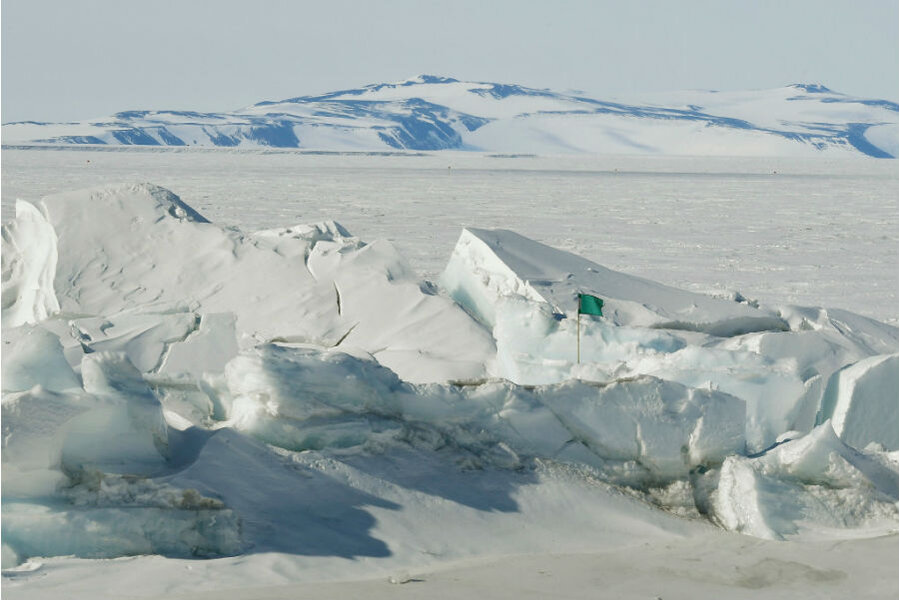Warming seas are attacking the West Antarctic Ice Sheet from the inside out
Loading...
A significant glacier that bounds the West Antarctic Ice Sheet is cracking from the inside out.
The Pine Island Glacier is a significant body of ice that has begun to show signs of wear due to rising global temperatures. In 2015, a 225-square-mile iceberg broke off the glacier and drifted away, a concerning prospect by itself. But researchers accidentally discovered when testing new imaging software that the major break started about 20 miles inland instead of at the edge of the ice shelf, where the ice would be expected to be at its weakest.
The evidence of a deep subsurface rift indicates that a warming ocean likely contributed to the breakup and will likely lead to more significant breaks in the near future. As the ice sheet breaks down, rising sea levels could potentially displace millions of people living in coastal regions all over the world.
"Rifts usually form at the margins of an ice shelf, where the ice is thin and subject to shearing that rips it apart," study leader Ian Howat, associate professor of earth sciences at Ohio State said in a press release. "However, this latest event in the Pine Island Glacier was due to a rift that originated from the center of the ice shelf and propagated out to the margins. This implies that something weakened the center of the ice shelf, with the most likely explanation being a crevasse melted out at the bedrock level by a warming ocean."
The study, published MOonday in Geophysical Research Letters, helps provide evidence for a phenomenon that scientists already suspected was at play in the Antarctic Ice Shelf, as the Christian Science Monitor's Rowena Lindsay previously explained:
While the glaciers sit on bedrock, a portion overflows into the sea, forming a floating ice shelf. The point of where the glacier begins to float is called the grounding line, and changing grounding lines, a result of ice melt, are thought to be strongly linked to the overall mass loss from the continent....
As the glaciers melt, more of their surface area is left exposed to the warm water underneath, which in turn pushes the grounding line further inland, creating a self-perpetuating cycle that is "unstable," as [Ala] Khazendar [a researcher with NASA’s Jet Propulsion Laboratory] told NPR.
Antarctica contains more than half of the world's fresh water in the form of ice, and much of that is contained in the West Antarctic Ice Shelf. Studies suggest that the ice shelf could collapse within the next 100 years, leading to potential rise in seas of up to 10 feet across the globe, endangering major cities like Miami or New York.
"It's generally accepted that it's no longer a question of whether the West Antarctic Ice Sheet will melt, it's a question of when," Dr. Howat said in the release. "This kind of rifting behavior provides another mechanism for rapid retreat of these glaciers, adding to the probability that we may see significant collapse of West Antarctica in our lifetimes."
The Pine Island Glacier and nearby Thwaites Glacier together block 10 percent of the West Antarctic Ice Sheet from draining into one of the the most active ice flows in the world. If valleys indicating subsurface rifts like the one observed on Pine Island Glacier in 2015 appear on those glaciers, it would likely be a sign that parts of the ice sheet are about to break off into the ice flow, further weakening the barrier between the sea and the ice shelf, say researchers.
By studying this kind of glacial breaking, scientists may be able to better predict when and how a catastrophic breakdown in the ice shelf might occur, but not how to stop it. Since the melting is driven largely by atmospheric warming, it's up to climate accords like the Paris Agreement to internationally reduce carbon emissions in order to slow warming.
"We need to understand exactly how these valleys and rifts form, and what they mean for ice shelf stability," Howat said. "We're limited in what information we can get from space, so this will mean targeting air and field campaigns to collect more detailed observations. The U.S. and the U.K. are partnering on a large field science program targeted at that area of Antarctica, so this will provide another piece to the puzzle."






